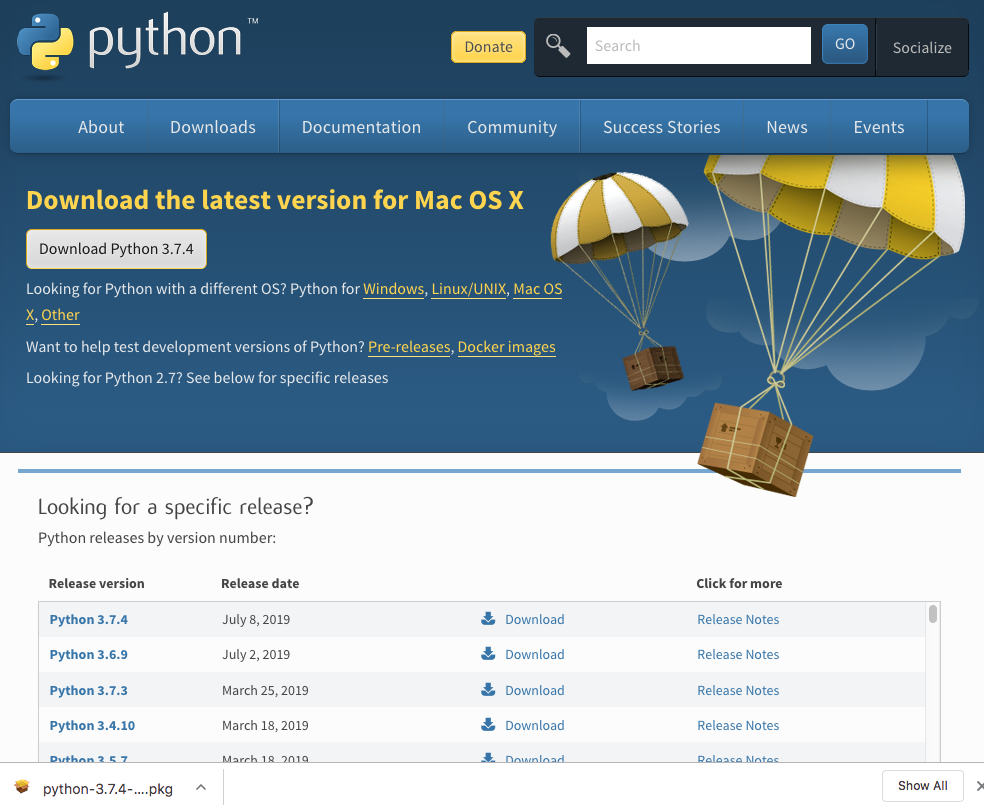- How To Install Python 3.8 On Mac Terminal
- Mac Install Python 3.8 Homebrew
- Mac Python 3.8 Install Ubuntu
Source code:Lib/sysconfig.py
The sysconfig module provides access to Python’s configurationinformation like the list of installation paths and the configuration variablesrelevant for the current platform.
Configuration variables¶
Precompiled Binaries for Mac OS X (x86) sqlite-tools-osx-x.zip (1.41 MiB) A bundle of command-line tools for managing SQLite database files. Python releases are now listed on the downloads page. This page only provides links to older releases which are not listed in the release database. Python 1.6.1 (September 2000) Python 1.5.2 (April 1999) Older source releases (1.0.1 - 1.6) Ancient source releases (pre 1.0) Python 1.5 binaries; Python 1.4 binaries; Python 1.3 binaries; Python 1.
A Python distribution contains a Makefile and a pyconfig.hheader file that are necessary to build both the Python binary itself andthird-party C extensions compiled using distutils.
sysconfig puts all variables found in these files in a dictionary thatcan be accessed using get_config_vars() or get_config_var().
Notice that on Windows, it’s a much smaller set.
sysconfig.get_config_vars(*args)¶With no arguments, return a dictionary of all configuration variablesrelevant for the current platform.
With arguments, return a list of values that result from looking up eachargument in the configuration variable dictionary.
For each argument, if the value is not found, return None.
sysconfig.get_config_var(name)¶Return the value of a single variable name. Equivalent toget_config_vars().get(name).
If name is not found, return None.
Example of usage:
Installation paths¶
Python uses an installation scheme that differs depending on the platform and onthe installation options. These schemes are stored in sysconfig underunique identifiers based on the value returned by os.name.
Every new component that is installed using distutils or aDistutils-based system will follow the same scheme to copy its file in the rightplaces.
Python currently supports seven schemes:
posix_prefix: scheme for POSIX platforms like Linux or Mac OS X. This isthe default scheme used when Python or a component is installed.
posix_home: scheme for POSIX platforms used when a home option is usedupon installation. This scheme is used when a component is installed throughDistutils with a specific home prefix.
posix_user: scheme for POSIX platforms used when a component is installedthrough Distutils and the user option is used. This scheme defines pathslocated under the user home directory.
nt: scheme for NT platforms like Windows.
nt_user: scheme for NT platforms, when the user option is used.
Each scheme is itself composed of a series of paths and each path has a uniqueidentifier. Python currently uses eight paths:
stdlib: directory containing the standard Python library files that are notplatform-specific.
platstdlib: directory containing the standard Python library files that areplatform-specific.
platlib: directory for site-specific, platform-specific files.
purelib: directory for site-specific, non-platform-specific files.
include: directory for non-platform-specific header files.
platinclude: directory for platform-specific header files.
scripts: directory for script files.
data: directory for data files.
sysconfig provides some functions to determine these paths.
sysconfig.get_scheme_names()¶Return a tuple containing all schemes currently supported insysconfig.
sysconfig.get_path_names()¶Return a tuple containing all path names currently supported insysconfig.

sysconfig.get_path(name[, scheme[, vars[, expand]]])¶Return an installation path corresponding to the path name, from theinstall scheme named scheme.
name has to be a value from the list returned by get_path_names().
sysconfig stores installation paths corresponding to each path name,for each platform, with variables to be expanded. For instance the stdlibpath for the nt scheme is: {base}/Lib.
get_path() will use the variables returned by get_config_vars()to expand the path. All variables have default values for each platform soone may call this function and get the default value.
If scheme is provided, it must be a value from the list returned byget_scheme_names(). Otherwise, the default scheme for the currentplatform is used.

If vars is provided, it must be a dictionary of variables that will updatethe dictionary return by get_config_vars().
If expand is set to False, the path will not be expanded using thevariables.
If name is not found, return None.
sysconfig.get_paths([scheme[, vars[, expand]]])¶Return a dictionary containing all installation paths corresponding to aninstallation scheme. See get_path() for more information.

If scheme is not provided, will use the default scheme for the currentplatform.
If vars is provided, it must be a dictionary of variables that willupdate the dictionary used to expand the paths.
If expand is set to false, the paths will not be expanded.
If scheme is not an existing scheme, get_paths() will raise aKeyError.

Other functions¶
sysconfig.get_python_version()¶Return the MAJOR.MINOR Python version number as a string. Similar to'%d.%d'%sys.version_info[:2].
sysconfig.get_platform()¶Return a string that identifies the current platform.
This is used mainly to distinguish platform-specific build directories andplatform-specific built distributions. Typically includes the OS name andversion and the architecture (as supplied by ‘os.uname()’), although theexact information included depends on the OS; e.g., on Linux, the kernelversion isn’t particularly important.
Examples of returned values:
How To Install Python 3.8 On Mac Terminal
linux-i586
linux-alpha (?)
solaris-2.6-sun4u
Windows will return one of:
win-amd64 (64bit Windows on AMD64, aka x86_64, Intel64, and EM64T)
win32 (all others - specifically, sys.platform is returned)
Mac OS X can return:
macosx-10.6-ppc
macosx-10.4-ppc64
macosx-10.3-i386
macosx-10.4-fat
For other non-POSIX platforms, currently just returns sys.platform.
sysconfig.is_python_build()¶Return True if the running Python interpreter was built from source andis being run from its built location, and not from a location resulting frome.g. running makeinstall or installing via a binary installer.
sysconfig.parse_config_h(fp[, vars])¶Parse a config.h-style file.
fp is a file-like object pointing to the config.h-like file.
A dictionary containing name/value pairs is returned. If an optionaldictionary is passed in as the second argument, it is used instead of a newdictionary, and updated with the values read in the file.
sysconfig.get_config_h_filename()¶Mac Install Python 3.8 Homebrew
Return the path of pyconfig.h.

sysconfig.get_makefile_filename()¶Return the path of Makefile.
Using sysconfig as a script¶
Mac Python 3.8 Install Ubuntu
You can use sysconfig as a script with Python’s -m option:
This call will print in the standard output the information returned byget_platform(), get_python_version(), get_path() andget_config_vars().
